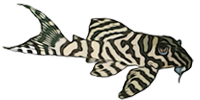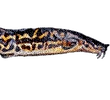Help. Semiaquilus dying
-
Daragh
- Posts: 144
- Joined: 11 Jan 2007, 21:41
- My cats species list: 66 (i:0, k:0)
- Location 1: Dublin, Ireland
- Interests: Photography and Fishkeeping (mainly cats, particularly Corys)
- Contact:
Help. Semiaquilus dying
I am about to lose my third Semiaquilus and I don’t know why. About a month ago I bought two groups of 6 (one lot were meant to be Fowleri) and I housed them in separate tanks as one lot have yellow leading ray on pec fins, others didn’t.
Group 1 in a 36” x 15” x 12” tank with 7 Weitzmani pH 6.8 Temp 23. Large air sponge filter and small internal filter. Décor playsand and java moss.
Group 2 in a wide 24” x 15” x 15” tank with 6 Sterbai and 3 Ancistrus Claro. Temp 25, pH 6.4. Large double sponge air filter and airstone. Décor: playsand, small bogwood and java moss.
Both tanks are tested weekly, results always 0 Ammonia. 0-5mg/l Nitrate and 0 Nitrite. 15% water changes twice weekly. As these were wild caught I treated them with Flubernol on arrival. No fish have been added to either tank since. Feeding, twice daily from a variety of Frozen Brineshrimp, Frozen Bloodworm, Tetra Tabimin, Tetra Prima, Aquarium Flake, Algae wafers and New Spectrum community mini pellets. All the other fish in the tanks are doing well and are lively, the Semis are always very quiet sitting around with their fins erect, but only coming to life when fed. They all eat well, but still look quite slim.
I found one dead in group 1 a week ago, not a mark. Three nights ago I found one on it’s side, breathing regularly but unable to remain upright in group 2. I floated it in a shallow container and added a little fresh water. It was dead within a couple of hours, again no marks. Tonight I have found another one in group 2 in a similar position.
1. Any suggestions for what I do immediately for the latest victim, otherwise he is into his last few hours?
2. Any ideas what could be causing these deaths?
3. Are Semiaquilus usually a “lazy” fish or should they be out and about and rooting around?
Any help greatly appreciated.
Group 1 in a 36” x 15” x 12” tank with 7 Weitzmani pH 6.8 Temp 23. Large air sponge filter and small internal filter. Décor playsand and java moss.
Group 2 in a wide 24” x 15” x 15” tank with 6 Sterbai and 3 Ancistrus Claro. Temp 25, pH 6.4. Large double sponge air filter and airstone. Décor: playsand, small bogwood and java moss.
Both tanks are tested weekly, results always 0 Ammonia. 0-5mg/l Nitrate and 0 Nitrite. 15% water changes twice weekly. As these were wild caught I treated them with Flubernol on arrival. No fish have been added to either tank since. Feeding, twice daily from a variety of Frozen Brineshrimp, Frozen Bloodworm, Tetra Tabimin, Tetra Prima, Aquarium Flake, Algae wafers and New Spectrum community mini pellets. All the other fish in the tanks are doing well and are lively, the Semis are always very quiet sitting around with their fins erect, but only coming to life when fed. They all eat well, but still look quite slim.
I found one dead in group 1 a week ago, not a mark. Three nights ago I found one on it’s side, breathing regularly but unable to remain upright in group 2. I floated it in a shallow container and added a little fresh water. It was dead within a couple of hours, again no marks. Tonight I have found another one in group 2 in a similar position.
1. Any suggestions for what I do immediately for the latest victim, otherwise he is into his last few hours?
2. Any ideas what could be causing these deaths?
3. Are Semiaquilus usually a “lazy” fish or should they be out and about and rooting around?
Any help greatly appreciated.
- husky_jim
- Posts: 325
- Joined: 11 Jul 2004, 11:11
- My images: 11
- My cats species list: 21 (i:0, k:0)
- My BLogs: 2 (i:1, p:80)
- Spotted: 12
- Location 2: Athens-Greece
- Interests: Music,Bikes,Dobermann and Catfish!!!
- Contact:
After being in several Peruvian shipments with C. Semiaquilus i have observe a big number of long term mortality mainly on full grown speciments.
I suggest to do a more 'advanced' karantine with both antiparasitic and antibiotic medicine.
I also suggest to try to give them natural foods like worms and if possible live ones.This will help...
What size are your fish?
I suggest to do a more 'advanced' karantine with both antiparasitic and antibiotic medicine.
I also suggest to try to give them natural foods like worms and if possible live ones.This will help...
What size are your fish?
-
wrasse
- Posts: 761
- Joined: 16 Feb 2007, 10:13
- My articles: 1
- My images: 9
- My cats species list: 22 (i:0, k:0)
- My aquaria list: 1 (i:0)
- Spotted: 5
- Location 1: Pailton, Warwickshire, UK
- Location 2: Pailton, Warwickshire, UK
- Interests: catfish, photography, gym, cooking
Your tank conditions are very good, as shown by your existing happy fish.
If its not too late for your sick fish you might try increasing the airation by a large degree and don't feed for a couple of days. Too much tampering might finish it off.....
I've not used flubenol, but I have been thinking about buying it for the same reason as you; wild fish. I reckon its not a mild medication. It might be harsh on newly aquired fish - perhaps they needed quarantining first, allowing time to adjust - and treating later on.
Good luck.
If its not too late for your sick fish you might try increasing the airation by a large degree and don't feed for a couple of days. Too much tampering might finish it off.....
I've not used flubenol, but I have been thinking about buying it for the same reason as you; wild fish. I reckon its not a mild medication. It might be harsh on newly aquired fish - perhaps they needed quarantining first, allowing time to adjust - and treating later on.
Good luck.
-
Daragh
- Posts: 144
- Joined: 11 Jan 2007, 21:41
- My cats species list: 66 (i:0, k:0)
- Location 1: Dublin, Ireland
- Interests: Photography and Fishkeeping (mainly cats, particularly Corys)
- Contact:
Thanx Jim. unfortunately he died before I got to do anything. I have used Flubernol many times before and always treat new fish especially wild caught. I don't think it is that "strong" a medication, it says you can safely overdose up to ten times the recommended amount, not that I would do that of course. I know fry are unaffected by it either. If it was to do with the flubernol, I suspect they would have died within a coupl eof days rather than waiting three or more weeks for the first one to die. I actually think I might try Flubernol again, as they are still in two groups I think I will try it on one of them anyway.
- Coryman
- Expert
- Posts: 2119
- Joined: 30 Dec 2002, 19:06
- My articles: 12
- My catfish: 5
- My cats species list: 83 (i:0, k:0)
- My BLogs: 1 (i:0, p:46)
- Spotted: 194
- Location 1: Kidderminster UK
- Location 2: Kidderminster, UK
- Interests: Cory's, Loricariids, photography and more Cory's
- Contact:
The biggest problem with C. semiaquilus is that they are very territorial and when a group are put together there is a lot of fighting and jockeying for dominance, which can and does will prove fatal for some members of the group. I have seen this in other members of the saddle snouted group, but C. semiaquilus seem to be the most aggressive towards each other.
Ian
Ian
- apistomaster
- Posts: 4735
- Joined: 10 Jun 2006, 14:26
- I've donated: $90.00!
- My articles: 1
- My cats species list: 12 (i:0, k:0)
- My Wishlist: 1
- Location 1: Clarkston, WA, USA
- Location 2: Clarkston, WA, USA
- Interests: Aquaculture and flyfishing
I would seriously consider using Praziquantal instead of Flubenol on new Corydoras. I think it has the edge over Flubenol in these fish. It is OK to use both because as you say, Flubenol has a low toxicity profile and may pick off a parasitic worm which is not affected by Praziquantal.
I realize it is too late this time. Just something to think about in the future. I know that a major importer of Corydoras uses Prazi and has good success.
I realize it is too late this time. Just something to think about in the future. I know that a major importer of Corydoras uses Prazi and has good success.
Avid Trout fly fisherman. ·´¯`·...¸><)))º>
- Coryman
- Expert
- Posts: 2119
- Joined: 30 Dec 2002, 19:06
- My articles: 12
- My catfish: 5
- My cats species list: 83 (i:0, k:0)
- My BLogs: 1 (i:0, p:46)
- Spotted: 194
- Location 1: Kidderminster UK
- Location 2: Kidderminster, UK
- Interests: Cory's, Loricariids, photography and more Cory's
- Contact:
Larry,
Praziquantal was derived from animal treatments and is not legal here in the UK, not sure if it is in Ireland though. It kills parasites by poisoning and this in some instances causes the parasite to release toxins, which can also cause problems to the host fish. This is also the reason it is not allowed to be used on food fish in the USA. Flubendazole treats worms and other parasites by stopping them feeding and there by they starve to death. Some of the egg-laying parasites will need repeated treatments to ensure they are eradicated.
Ian
Praziquantal was derived from animal treatments and is not legal here in the UK, not sure if it is in Ireland though. It kills parasites by poisoning and this in some instances causes the parasite to release toxins, which can also cause problems to the host fish. This is also the reason it is not allowed to be used on food fish in the USA. Flubendazole treats worms and other parasites by stopping them feeding and there by they starve to death. Some of the egg-laying parasites will need repeated treatments to ensure they are eradicated.
Ian






